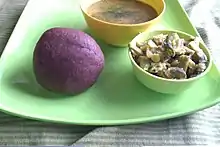Cuisine of Karnataka
The cuisine of Karnataka includes the cuisines of the different regions and communities of Karnataka, namely, North Karnataka cuisine, South Karnataka cuisine, Udupi cuisine, Saraswat cuisine, Coorg cuisine, Mangalorean Catholic cuisine and Navayath cuisine.[1][2]
 |
| This article is part of the series on |
| Indian cuisine |
|---|
|
| Part of a series on the |
| Culture of Karnataka |
|---|
 |
Karnataka cuisine includes both vegetarian and non-vegetarian. Ragi, which is a staple in Kannadiga cuisine is mentioned in the works of the poet Adikavi Pampa and in the ancient Sanskrit medical text Sushruta Samhita.[3]
Following are some of the different cuisines from Karnataka :
- Uttara Karnataka Cuisine
- Karwar cuisine
- Udupi Cuisine
- Mangaluru cuisine
- Kodagu or coorg cuisine
- Mysuru - Mandya cuisine
- Dakshina Kannada cuisines
- Malnad cuisine
- Ballari - Raichur cuisine
- Davangere cuisine etc
North Karnataka cuisine


North Karnataka cuisine, encompassing the region of North Karnataka, has a diverse collection of dishes. However, for the most part, these dishes are vegetarian due to the dominance of the vegetarian Lingayat community in the area. The cuisine is based on jowar (sorghum/millet) and wheat, made into jolada rotis, made from jowar.
A typical Lingayat meal consists of jolada rooti, along with several kinds of curries and palyas. Palyas are made of vegetables sauteed and seasoned with various spices. These include jowari doddmensinkayi palya (capsicum curry), gulagayi yenagai (Brinjal fry), jowari mensinkayi (fried chilli), as well as majjige saaru (buttermilk curry). The palyas can be from any vegetable currently in season. Another common item is jhunka, steamed cubes of gram flour dusted with sesame and coriander. During festival times, Lingayats make soute bija huggi, pellets of broken wheat dough that are tedious to make. Other festival dishes include various kinds of kadubu (dumplings), made out of wheat or other flour and occasionally stuffed.
The region is also known for its various powders, commonly put into cuisines. These are made of agasi (flax), yellu (sesame), shenga (groundnut), puttani (channa dal) and gurelu/ucchal (Niger seed), and are added as seasoning to various dishes.

Cuisine in Belagavi is similar to Maharashtrian cuisine, including a prevalence of chili. This cuisine also uses jolada, has several Marathi dishes including rassa (a fiery curry made from chilis) or sukka (a dry fry). This area also uses more meat such as chicken or mutton, similar to Maharashtra. Cuisine in Hyderabad-Karnataka has influences from that region: including gongura. Popular dishes include many Hyderabadi favourites such as Biryani, keema balls, dalcha and bread ka meetha.
Coastal Karnataka Cuisine

Coastal Karnataka is home to many different ethnolinguistic communities, and so its cuisines are similarly diverse. Common to most people there is the use of fish, especially in Uttara Kannada. The main dish in Uttara Kannada is fish curry, along with rice. Mangalore, however, has multiple communities and so is famed for many dishes. Some of these include neer dosa, kori rotti and Mangalore buns. The most popular dish is the various seafood curries, locally known as gassi. These curries are made unique by the use of jaargey, also known as Malabar tamarind, a fruit local to the region with a sour exterior.

On the other extreme is Udupi cuisine, found in the temple town of Udupi midway between Uttara Kannada and Mangalore. Unlike the others, this cuisine has only vegetarian dishes and adheres strictly to the definition of sattvic food, and excludes onion and garlic. Therefore, this cuisine is mostly found among the Brahmins of the region. This food includes sambar, rasam and a variety of lemon rice called chitranna by Brahmins. Dosa is believed by some to originate from the area.
South Karnatakan Cuisine




.JPG.webp)
The staples of South Karnataka food is rice and ragi (finger millet). Since rice is relatively expensive compared to ragi, ragi is the primary food for those living in rural areas. This cuisine uses some of the same dishes as Udupi cuisine: including kosambri and spiced rice. A typical meal consists of ragi mudde along with some sort of saaru: a stew including spices and a special ingredient. Bassaru is a spicy, lentil-based vegetable stew, while uppusaaru is a milder soup typically eaten with uppankai (pickle). The most popular saaru in the region is soppina saaru, made with greens, and is most commonly eaten on a working day. Another popular item is koli saaru, chicken sambar, but mutton is also consumed, especially during festivals. Other significant dishes are avarekalu, beans consumed during the winter, and bisi bele bath, a way of cooking rice along with vegetables, essentially combining sambar and rice in a single dish. The mud idli was invented in the 1940s, during a rice shortage, in MTR, Bengaluru. Other important dishes include upma (called upittu).

Kodava cuisine has some significant differences from typical South Karnataka cuisine, the most important being the prevalence of pork dishes.
References
- "6 Things You Need to Know About Karnataka's Local Cuisine". Culture Trip.
- "Forgotten Flavours". Deccan Herald.
- "Karnataka Cuisine – Diverse culinary traditions". Fashionable Foodz.
External links
 Media related to Cuisine of Karnataka at Wikimedia Commons
Media related to Cuisine of Karnataka at Wikimedia Commons